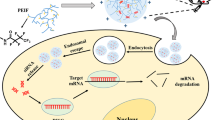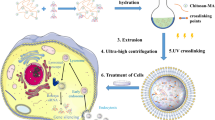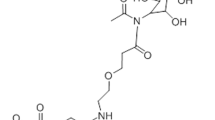Abstract
Small interfering RNAs (siRNAs) are emerging as promising therapeutic tools. However, the widespread clinical application of such molecules as modulators of gene expression is still dependent on several aspects that limit their bioavailability. One of the most promising strategies to overcome the barriers faced by gene silencing molecules involves the use of lipid-based nanoparticles (LNPs) and viral vectors, such as adenoviruses (Ads). The primary obstacle for translating gene silencing technology from an effective research tool into a feasible therapeutic strategy remains its efficient delivery to the targeted cell type in vivo. In this study, we tested the capability of LNPs and Ad to transduce and treat locally tumors in vivo. Efficient knockdown of a surrogate reporter (luciferase) and therapeutic target genes such as the kinesin spindle protein (KIF11) and polo-like kinase 1 were observed. Most importantly, this activity led to a cell cycle block as a consequence and slowed down tumor progression in tumor-bearing animals. Our data indicate that it is possible to achieve tumor transduction with si/short hairpin RNAs and further improve the delivery strategy that likely in the future will lead to the ideal non-viral particle for targeted cancer gene silencing.
This is a preview of subscription content, access via your institution
Access options
Subscribe to this journal
Receive 12 print issues and online access
$259.00 per year
only $21.58 per issue
Buy this article
- Purchase on Springer Link
- Instant access to full article PDF
Prices may be subject to local taxes which are calculated during checkout




Similar content being viewed by others
References
Zamore PD, Tuschl T, Sharp PA, Bartel DP . RNAi: double-stranded RNA directs the ATP-dependent cleavage of mRNA at 21 to 23 nucleotide intervals. Cell 2000; 101: 25–33.
Alexopoulou L, Holt AC, Medzhitov R, Flavell RA . Recognition of double-stranded RNA and activation of NF-kappaB by Toll-like receptor 3. Nature 2001; 413: 732–738.
McCaffrey AP, Meuse L, Pham TT, Conklin DS, Hannon GJ, Kay MA . RNA interference in adult mice. Nature 2002; 418: 38–39.
Hornung V, Guenthner-Biller M, Bourquin C, Ablasser A, Schlee M, Uematsu S et al. Sequence-specific potent induction of IFN-alpha by short interfering RNA in plasmacytoid dendritic cells through TLR7. Nat Med 2005; 11: 263–270.
Song XT, Evel-Kabler K, Rollins L, Huang XF, Chen SY . An alternative and effective HIV vaccination approach based on inhibition of antigen presentation attenuators in dendritic cells. PLoS Med 2006; 3: e11.
Peng S, Kim TW, Lee JH, Yang M, He L, Hung CF et al. Vaccination with dendritic cells transfected with BAK and BAX siRNA enhances antigen-specific immune responses by prolonging dendritic cell life. Hum Gene Ther 2005; 16: 584–593.
Kim TW, Lee JH, He L, Boyd DA, Hardwick JM, Hung CF et al. Modification of professional antigen-presenting cells with small interfering RNA in vivo to enhance cancer vaccine potency. Cancer Res 2005; 65: 309–316.
Wesche-Soldato DE, Chung CS, Lomas-Neira J, Doughty LA, Gregory SH, Ayala A . In vivo delivery of caspase-8 or Fas siRNA improves the survival of septic mice. Blood 2005; 106: 2295–2301.
Braasch DA, Paroo Z, Constantinescu A, Ren G, Oz OK, Mason RP et al. Biodistribution of phosphodiester and phosphorothioate siRNA. Bioorg Med Chem Lett 2004; 14: 1139–1143.
Corey DR . Chemical modification: the key to clinical application of RNA interference? J Clin Invest 2007; 117: 3615–3622.
Morrissey DV, Lockridge JA, Shaw L, Blanchard K, Jensen K, Breen W et al. Potent and persistent in vivo anti-HBV activity of chemically modified siRNAs. Nat Biotechnol 2005; 23: 1002–1007.
Michiue H, Eguchi A, Scadeng M, Dowdy SF . Induction of in vivo synthetic lethal RNAi responses to treat glioblastoma. Cancer Biol Ther 2009; 8: 2306–2313.
Pathak A, Vyas SP, Gupta KC . Nano-vectors for efficient liver specific gene transfer. Int J Nanomedicine 2008; 3: 31–49.
Schroeder A, Levins CG, Cortez C, Langer R, Anderson DG . Lipid-based nanotherapeutics for siRNA delivery. J Intern Med 2010; 267: 9–21.
de Fougerolles A, Novobrantseva T . siRNA and the lung: research tool or therapeutic drug? Curr Opin Pharmacol 2008; 8: 280–285.
Abrams MT, Koser ML, Seitzer J, Williams SC, DiPietro MA, Wang W et al. Evaluation of efficacy, biodistribution and inflammation for a potent siRNA nanoparticle: effect of dexamethasone co-treatment. Mol Ther 2010; 18: 171–180.
Wang QZ, Lv YH, Diao Y, Xu R . The design of vectors for RNAi delivery system. Curr Pharm Des 2008; 14: 1327–1340.
Ruiz R, Witting SR, Saxena R, Morral N . Robust hepatic gene silencing for functional studies using helper-dependent adenovirus vectors. Hum Gene Ther 2008; 20: 87–94.
Sakamoto N, Tanabe Y, Yokota T, Satoh K, Sekine-Osajima Y, Nakagawa M et al. Inhibition of hepatitis C virus infection and expression in vitro and in vivo by recombinant adenovirus expressing short hairpin RNA. J Gastroenterol Hepatol 2008; 23: 1437–1447.
Zhu H, Zhu Y, Hu J, Hu W, Liao Y, Zhang J et al. Adenovirus-mediated small hairpin RNA targeting Bcl-XL as therapy for colon cancer. Int J Cancer 2007; 121: 1366–1372.
Dai Y, Qiao L, Chan KW, Yang M, Ye J, Zhang R et al. Adenovirus-mediated down-regulation of X-linked inhibitor of apoptosis protein inhibits colon cancer. Mol Cancer Ther 2009; 8: 2762–2770.
Zheng JN, Pei DS, Mao LJ, Liu XY, Mei DD, Zhang BF et al. Inhibition of renal cancer cell growth in vitro and in vivo with oncolytic adenovirus armed short hairpin RNA targeting Ki-67 encoding mRNA. Cancer Gene Ther 2009; 16: 20–32.
Zhang Y, Xu W . Progress on kinesin spindle protein inhibitors as anti-cancer agents. Anticancer Agents Med Chem 2008; 8: 698–704.
Jackson JR, Patrick DR, Dar MM, Huang PS . Targeted anti-mitotic therapies: can we improve on tubulin agents? Nat Rev Cancer 2007; 7: 107–117.
Schmidt M, Bastians H . Mitotic drug targets and the development of novel anti-mitotic anticancer drugs. Drug Resist Updat 2007; 10: 162–181.
McManus MT, Sharp PA . Gene silencing in mammals by small interfering RNAs. Nat Rev Genet 2002; 3: 737–747.
Dorn G, Patel S, Wotherspoon G, Hemmings-Mieszczak M, Barclay J, Natt FJ et al. siRNA relieves chronic neuropathic pain. Nucleic Acids Res 2004; 32: e49.
Soutschek J, Akinc A, Bramlage B, Charisse K, Constien R, Donoghue M et al. Therapeutic silencing of an endogenous gene by systemic administration of modified siRNAs. Nature 2004; 432: 173–178.
Davis ME, Zuckerman JE, Choi CHJ, Seligson D, Tolcher A, Alabi CA et al. Evidence of RNAi in humans from systematically administered siRNA via targeted nanoparticles. Nature 2010; 464: 1067–1071.
Knight SD, Parrish CA . Recent progress in the identification and clinical evaluation of inhibitors of the mitotic kinesin KSP. Curr Top Med Chem 2008; 8: 888–904.
Rickert KW, Schaber M, Torrent M, Neilson LA, Tasber ES, Garbaccio R et al. Discovery and biochemical characterization of selective ATP competitive inhibitors of the human mitotic kinesin KSP. Arch Biochem Biophys 2008; 469: 220–231.
Cox CD, Coleman PJ, Breslin MJ, Whitman DB, Garbaccio RM, Fraley ME et al. Kinesin spindle protein (KSP) inhibitors. 9. Discovery of (2S)-4-(2,5-difluorophenyl)-n-[(3R,4S)-3-fluoro-1-methylpiperidin-4-yl]-2- (hydroxymethyl)-N-methyl-2-phenyl-2,5-dihydro-1H-pyrrole-1-carboxamide (MK-0731) for the treatment of taxane-refractory cancer. J Med Chem 2008; 51: 4239–4252.
Steegmaier M, Hoffmann M, Baum A, Lénárt P, Petronczki M, Krssák M et al. BI 2536, a potent and selective inhibitor of polo-like kinase 1, inhibits tumor growth in vivo. Curr Biol 2007; 17: 316–322.
Spankuch B, Kurunci-Csacsko E, Kaufmann M, Strebhardt K . Rational combinations of siRNAs targeting Plk1 with breast cancer drugs. Oncogene 2007; 26: 5793–5807.
Appledorn DM, Patial S, McBride A, Godbehere S, Van Rooijen N, Parameswaran N et al. Adenovirus vector-induced innate inflammatory mediators, MAPK signaling, as well as adaptive immune responses are dependent upon both TLR2 and TLR9 in vivo. J Immunol 2008; 181: 2134–2144.
Dharmapuri S, Peruzzi D, Aurisicchio L . Engineered adenovirus serotypes for overcoming anti-vector immunity. Expert Opin Biol Ther 2009; 9: 1279–1287.
Renaut L, Bernard C, D’Halluin JC . A rapid and easy method for production and selection of recombinant adenovirus genomes. J Virol Methods 2002; 100: 121–131.
Author information
Authors and Affiliations
Corresponding author
Ethics declarations
Competing interests
The authors declare no conflict of interest.
Rights and permissions
About this article
Cite this article
Dharmapuri, S., Peruzzi, D., Marra, E. et al. Intratumor RNA interference of cell cycle genes slows down tumor progression. Gene Ther 18, 727–733 (2011). https://doi.org/10.1038/gt.2011.27
Received:
Revised:
Accepted:
Published:
Issue Date:
DOI: https://doi.org/10.1038/gt.2011.27
Keywords
This article is cited by
-
Progress Toward In Vivo Use of siRNAs-II
Molecular Therapy (2012)



